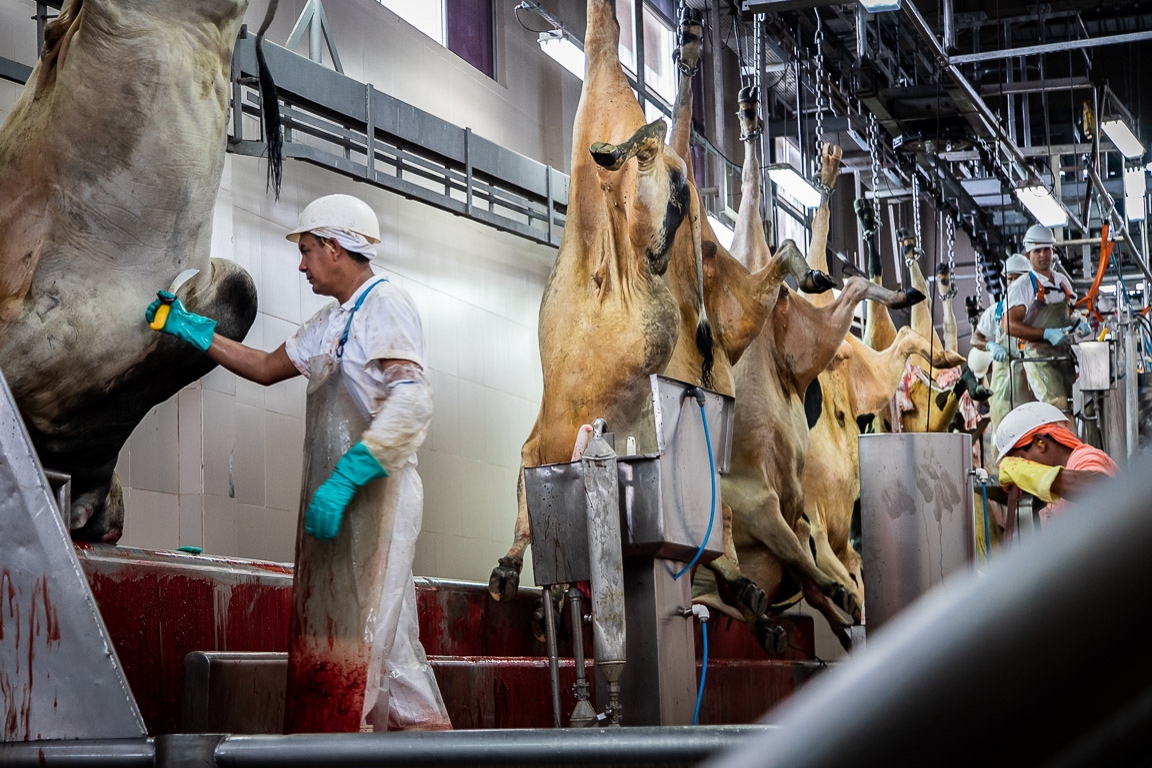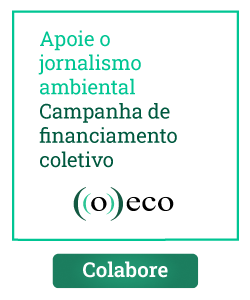Between 2016 and 2020, 26 new cattle slaughterhouses were registered inside the Brazilian Amazon, bringing the total number of meatpackers in the region up to 183. This is worrisome news, given the fact that cattle farming is the largest contributing factor to deforestation in the Amazon, generates large quantities of greenhouse gases, and is responsible for one-third of cases of slave-type labor in Brazil. But the data — obtained exclusively by the environmental journalism platform ((o))eco and researchers from the conservation nonprofit Imazon, who have been monitoring the sector since the 1990s — have raised yet another concern: while 50% of humanity has isolated itself to avoid the proliferation of COVID-19, these meat plants could be ground zero for the next pandemic.
“It’s as if we were sleeping in a minefield and suddenly got up and began wandering around aimlessly — a behavior that could trigger a bomb at any minute,” says Ana Lúcia Tourinho, an ecologist and researcher at Mato Grosso Federal University (UFMT). “Meatpackers will have to undergo a sanitation restructure because they are time bombs and centers for spreading COVID-19 and other illnesses.”
The current pandemic has made it clear that the combination of refrigerated environments needed to preserve meat and crowded production lines make meatpacking plants hotspots for the proliferation of the new coronavirus. In the United States, 115 plants reported COVID-19 outbreaks among their employees, 30 of them needing to shut down production due to the seriousness of the situation. These include plants run by Brazilian-owned JBS and Marfrig, the world’s two biggest meatpackers. In Brazil, the Ministry of Labor (MPT) carried out an investigation into infections among workers at 61 meat processors in 11 states.
But COVID-19 isn’t the only disease nurtured in such an environment.
Slaughterhouses are also ideal locations for the emergence of new viruses and bacteria due to the forced proximity of humans and animals, where workers come into contact with the blood and entrails of various species. “If I were to install a mechanism for the health surveillance department to detect new viruses, I would undoubtedly do it inside meatpacking plants,” says veterinarian Carlos Abrahão, a specialist in invasive species and advocate of the One Health principle that sees environmental, human and animal health as being inextricably linked.
Sixty percent of all new infectious diseases originate in animals, scientists have determined. Coronaviruses are an especially dangerous category because there is already evidence that SARS-CoV-2, which causes COVID-19, has adapted to infect human beings. There are indications it may have originated from a bat or snake sold at a wildlife market in Wuhan, China, where the outbreak began.
The main factor causing this jump between species to happen is the deforestation of the habitats where wildlife previously lived undisturbed. According to a study by USAID, 31% of cases where diseases spread from animals to humans occurred because their natural environments were invaded and destroyed.
The Amazon, where record rates of deforestation were reported during the first quarter of 2020 (an area almost the size of New York City was razed between January and March), is home to the planet’s greatest biodiversity. There are 160 bat species identified there, and researchers have found 3,204 different types of coronaviruses in bat populations across Brazil.
Keeping forests standing is fundamental because the vegetation works as a barrier to the dispersal of these microorganisms. “The more diverse a region is, the safer it is in epidemiological terms,” Abrahão says. “In the Amazon, it is normal to have only a few individuals of a species in a restricted region. This makes it difficult for a virus or parasite to jump from one population to another because they are isolated.” The problem is when someone deforests the area and introduces hundreds of individuals of just one species — like cattle, for example.
Forest becomes pasture and the dollars roll in
On average, two-thirds of the forest cut down in the Brazilian Amazon every year is turned into pasture. Cattle are used not only to demarcate territory — a tactic used by land-grabbers to invade public lands so they can sell it illegally later on — but also to sustain those who actually make a living from raising cattle. In this case, the activity supplies local businesses as well as the large meatpackers who sell their products to supermarket chains in Brazil and abroad.
The large meatpackers operating in the Amazon are under pressure to guarantee that their production is free of animals raised in illegally deforested areas. But the industry-led measures to ensure this, including legal accords, have not been effective in achieving their aim. Over the past year, international investors have demanded that Brazilian meatpackers eliminate deforestation from their supply chains. But JBS, Marfrig and Minerva, the three giants leading the beef industry, continue to receive foreign revenue, investments and loans despite the fact that their 41 Amazonian operations are not 100% deforestation-free. In 2017, the three companies accounted for 42% of the active slaughtering capacity in the forest. Imazon rates the companies first, fifth and 10th on its ranking of exposure to deforestation.

The pandemic has made it clear that these companies’ activities in the Amazon pose an even greater risk than deforestation. If a new virus were to appear at these meatpacking plants, it could quickly spread throughout Brazil and other nations, harming not only the meat sector but the economy as a whole. But the industry appears unaware of the danger posed to public health. “This is still way off the radar of investors,” says Mônica de Bolle, an economist and professor at Johns Hopkins University in the U.S. “We still don’t know enough about how these new viruses emerge and propagate. Brazilian and American businessmen and politicians use a standard communication to say that this is a quick, passing crisis. It is disconnected from reality.”
In fact, the Brazilian beef industry has performed well on the financial market during the crisis. Despite expectations of a shrinking GDP in 2020, Marfrig shares traded at their highest price since 2011 on May 13. Minerva reported its biggest net profit of the past 12 months between January and March, and its latest shareholder report was optimistic: “For the coming quarters, strong international demand and supply problems at other beef exporters will tend to directly benefit the South American players, consolidating the region as the major global beef producer. Minerva Foods … is ready to take advantage of the opportunities that will be created.”
JBS has been more cautious: in its quarterly report, it notes the shutdown of its units in Brazil and the U.S. and says that “at this moment, there is no way to specify the medium and long-term impacts on the economic scenario and Company operations.” From January to May, its stock price fell 19.2%, but remains higher than other market giants like Atacadão, Ambev and Petrobras.
In China, the swine flu, the trade war with the U.S., and the approval for new Brazilian meatpackers to export to the Asian giant have pushed sales of Brazilian beef overseas. From January to April 2020, exports to China doubled in comparison to the same period last year. After a drop in sales in February as the pandemic was declared, sales to China revved up and came back with full force in March. “On the medium to long term, I believe the trend will be a more robust beef export sector in Brazil,” says José Clavijo, an agricultural commodities analyst at Refinitiv, which produces data and reports for investors.
Climate crisis could invert market logic
In March, the Brazilian stock exchange had to hit the circuit breaker and freeze operations six times over a 10-day period — an action taken when stock prices drop too far to be absorbed by the market. Some analysts say these frenetic ups and downs may be the new normal for the financial market. This is because the effects the stock market has felt as a result of the pandemic are similar to those that could be repeated as climate emergencies accelerate over time.
“It is clear that there are differences, but climate change could also lead to a humanitarian and financial crisis similar to this one caused by COVID-19: physical structures of nations being destroyed, for example, or damages brought on by flooding or long drought periods,” says Cole Martin of Fitch Solutions, who helps companies and investors identify risks and perspectives in diverse sectors of the economy.

The Bank for International Settlements (BIS), a Swiss-based institution known as the central bank of central banks, endorses this thesis. According to the organization’s deputy general manager, Luiz Awazu Pereira da Silva, COVID-19 “presents a vivid image of how the future will be if nothing is done to reduce greenhouse gases.”
The fossil fuel sector was the first to feel the impact. For the first time in history, the price of a barrel of oil in the U.S. fell below zero, reaching negative $37.63 — meaning producers were paying buyers to take on their glut. Oil and gas share prices became what the financial market calls stranded assets. “Stranded assets used to be a niche idea,” Bloomberg sustainable finance editor Emily Chasan wrote at the end of April. “We have been seeing the prophecy come true in recent weeks in the oil and natural gas sector.”
With forecasts for a 3% retraction of the global economy this year — the largest in nearly a century — streets and establishments may remain empty even after reopening and the lifting of stay-at-home orders. “Empty restaurants. Theaters and hotels closed. Airplanes grounded. At least for now, all of these can be classified as stranded assets, subject to sudden devaluations and operational losses,” Chasan wrote.
Investor inertia raises concern
The warning signs for the cattle-farming sector are clear. Consumer behavior is changing with the pandemic. Russia suspended exports of some food products to prioritize supply for its domestic market, and in eastern Africa, fears about food security led people to buy local fish over Chinese imports. In Asia, interest is growing in vegetable protein, whose sales remain weak in comparison to beef.
And now there is also the threat of contaminants in the production environment and concerns about future epidemics as the meatpacking industry spreads across the Amazon. All this adds to the earlier problem: the high volumes of greenhouse gas emissions associated with the beef production chain. In 2018, cattle farming produced 19% of the emissions in Brazil, a number that jumps to 45% if deforestation in the Amazon is included.
But none of this was enough to set off alarms at companies or investment firms, which seem to have nothing to do with the risks involved with financing meatpackers in the Amazon. “When we tell an investor that he will lose money in the medium term with oil and fossil fuels because these assets will become stranded, he knows exactly what and where these assets are,” says Natalie Unterstell of Talanoa Solutions, a consulting firm that specializes in projects to reduce the impact caused by climate change. “Deforestation is much more diffuse. People even link deforestation to climate change, but it is more difficult for an investor to understand that the financial product is also associated with deforestation.”
It’s a behavior already identified by the BIS, whose analysts warn that both the pandemic and climate change are “green swans,” a term used to describe risks that are highly likely to materialize but which are too complex to be totally understood.
Investor reaction to concerns raised about the beef industry is similar to the response that scientists received when, in 2007, they pointed out the high probability of a coronavirus epidemic: they were ignored. “I have been trying to advise people that this would happen since the end of the 1990s. We are playing around with scientific knowledge,” says Tourinho from UFMT.
Only time will tell how it all plays out. “With 0.1% of the funds being spent on the pandemic today, we could create a global system to prevent this type of problem,” says Abrahão, the veterinarian. “You just have to invest it in the right things — which is basic science, research and public health — to not have another COVID-19. It also involves greater care with nature, because human, animal and environmental health are interdependent.”
Responses from the companies
Marfrig, meatpacker (read the full response here):
Marfrig affirms that it has been adopting a series of COVID-19 monitoring and prevention measures inside all of its production units and offices, including daily body temperature measurement of all 18,000 employees and increased intervals between work shifts. The company reinforces the fact that it monitors its cattle suppliers in the Amazon so as to avoid purchasing cattle from illegally deforested land. Marfrig also cites many initiatives to promote low-carbon cattle raising, including an unprecedented partnership with EMBRAPA (the Brazilian Agricultural Research Corporation) to foment the adoption of more sustainable practices among cattle farmers.
Minerva, meatpacker (read the full response here):
Minerva affirms that it has been operating under a rigorous contingency plan to protect the health of its employees and care for production safety, while still assuring food supply to the public. The processing plants are operating at 70% capacity to ensure safe distancing during operations, employees are being tested for coronavirus and body temperatures are being monitored. As to possible impacts on investors, the company affirms that Brazil is very well positioned to attend global market needs, as all plants are adhering to rigid sanitation controls and are being monitored by onsite inspectors from the Federal Inspection Service (SIF), part of the Ministry of Agriculture.
JBS, meatpacker (read the full response here and here):
JBS affirms that all of the cattle farms supplying the company are monitored via satellite imagery and georeferenced data on the property. All properties where deforestation has occurred are excluded. The company also affirms that it has, since the start of the pandemic, adopted a rigorous protocol for the control and prevention of COVID-19 at its units. This protocol includes removing all employees in high-risk groups from the site, measuring employee body temperatures and distancing.
*Translated by Maya Johnson and published in english by Mongabay.
Leia também

Labirinto de papéis e falta de transparência ocultam investimento em desmatadores
Enquanto poupadores individuais não têm ideia de onde seu dinheiro é aplicado, grandes financiadores camuflam participação em empresas que estimulam derrubadas na Amazônia →

TAC da Carne no Pará: MPF diz que ninguém está livre do desmatamento
Passados 10 anos do início dos acordos com os frigoríficos, nova rodada de auditorias aponta menos irregularidades, mas ainda há brechas para gado de desmatamento chegar ao mercado →

Desmatamento na Amazônia atinge nível recorde no primeiro trimestre de 2020
Desmatamento de janeiro a março de 2020 chega a 796km², 51% a mais do que em 2019. Acumulado desde agosto já ultrapassa 5 mil km² desmatados →









